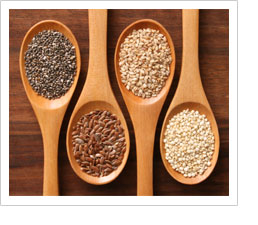
Ancient Grains
There are many grains and seeds which fall into the category of ancient: amaranth, barley, buckwheat, freekeh, farro, kamut (i.e. khorasan wheat), millet, quinoa, sorghum, spelt, teff; and chia, flax, and sesame seeds.
Why the relatively recent popularity/interest in ancient grains and seeds? They are more nutritious than modern grains. They are an excellent source of carbohydrate, many also contain complete protein, they have higher amounts insoluble fibre, and are a great source of vitamins and minerals, and some are gluten free.
Ancient grains and seeds have retained their nutritional value and rich taste in part because they have been relatively untouched by modern plant science. In contrast, food engineers breed modern grains and seeds for high crop yields, pest resistance and improved tolerance for storage and handling—not for flavor or nutritional value.
These are the most popular of the ancient grains. Starting with my personal favourite…
Buckwheat:
Buckwheat is actually a fruit seed (not a grain) that is related to rhubarb and sorrel. It has been providing essential nutrients, vitamins, energy, and fiber to humanity for approximately 8,000 years Similar to amaranth it is also a good source of high quality protein as it contains all eight essential amino acids, including lysine; and it is high in dietary fibre. Being a seed it is gluten free. In terms of micronutrients, buckwheat contains higher levels of zinc, copper, and manganese than other cereal grains.
Tips: Whole Buckwheat can be roasted and add to salads or muesli for extra crunch. Cooked buckwheat is a great substitute for brown rice. Buckwheat flour is commonly used for pancakes and baking.
Amaranth:
Technically a seed (or a pseudo-grain), Amaranth originates in South America and is a unique grain in that it contains the essential amino acid Lysine – a rare find in most grains. Like the majority of ancient grains it’s high in protein but with the added bonus that one cup of cooked amaranth contains ~10{4f7bf5ffc4dd2943527b9e13cad40ba8015823b935bc089078976a593dc77d18} of your daily calcium needs and ~50{4f7bf5ffc4dd2943527b9e13cad40ba8015823b935bc089078976a593dc77d18} of your daily iron needs making it a great option for vegetarians or those who limit red meat and dairy foods in their diet. It’s also gluten free.
Tips: Cook in a saucepan of water or stock and use in place of rice or cous cous. Alternatively, use it as a substitute to oats for your morning porridge. Amaranth flour can also be used for baking.
Millet:
Millet actually refers to a group of several small grains – the most widely grown millet crop is pearl millet. It’s traditionally a staple food in India but is eaten throughout the world. It has a similar carbohydrate and protein profile to pasta but is gluten free.
Tips: Millet can be eaten sweet or savoury. Use it similar to rice to stuff vegetables such as capsicum, or cook like polenta and create millet chips. Millet flour is great for baking and bread making.
Spelt:
Originating in Ancient Egypt and popular in Europe during Medieval times, Spelt is an ancient species of wheat meaning that it is not gluten free but can be tolerated by some people with wheat sensitivities. It has a nutty flavour and is higher in protein than regular wheat flour.
Tips: Spelt flour can be used to make muffins, pancakes, waffles and bread or the wholegrain can be boiled and used in salads.
Teff:
One of the smallest grains in the world – smaller than a poppy seed, Teff is a staple grain in Ethiopia where they used it to make a flatbread known as injera. It is a gluten free grain and rich in calcium and iron (having similar levels of both these micronutrients to amaranth). Teff is high in resistant starch, a type of dietary fiber that can benefit blood-sugar management, weight control, and colon health.
Tips: Teff can be used similar to other seeds and added to salads or baking for extra crunch. It can also be added to a smoothie to boost the nutritional profile. Teff flour is great for pancakes and baking, and using as a thickener for stews and gravy.
Quinoa:
Probably the most familiar of the ancient grains, quinoa has quickly grown in popularity over recent years due to it’s high protein content and lack of gluten making it an ideal grain substitute for those with coeliac disease, or non coeliac gluten sensitivity. Technically a seed not a grain, quinoa is considered to be a complete protein – meaning that it contains all eight essential amino acids.
Tips: Recipe options for quinoa are endless but it makes a great addition to salads where you would usually use couscous or rice. Quinoa flakes are a great for making porridge – and go well with almond or coconut milk.
How many have you tried ? Quinoa and Chia have been hugely popular in recent years, but as you can see there are many others to try, and incorporate into your diet on a regular basis.
Tamara Madden is a qualified clinical nutritionist, and specialist in endurance sports. She believes athletes need real food, not processed and packaged foods to fuel themselves during the hours of training, to support their immune system, and make sure they are in the best shape possible at the start line.

